Human Resource Development Report: Learning, Training, and Government
VerifiedAdded on 2020/06/05
|20
|4678
|50
Report
AI Summary
This report delves into the realm of Human Resource Development (HRD), focusing on various aspects such as learning styles, training methods, and the role of government initiatives. It begins by comparing different organizational learning styles, including Kolb's and Honey and Mumford's models, and analyzes the significance of the learning curve and its transfer to the workplace. The report then examines the contributions of different learning styles and theories to the planning and design of a learning curve. Furthermore, it explores the government's role in training, development, and lifelong learning, along with the impact of the competency movement on both public and private sectors. Contemporary training initiatives introduced by the UK government are also discussed. The report also compares staff training needs at various levels, evaluates different training methods, and outlines a systematic approach to planning a training event, including evaluation methods and their success. The case study of Sun Court Ltd. is used to illustrate the practical application of HRD principles, offering insights into how organizations can improve employee performance and achieve their business objectives.

HUMAN
RESOURCE
DEVELOPMENT
RESOURCE
DEVELOPMENT
Paraphrase This Document
Need a fresh take? Get an instant paraphrase of this document with our AI Paraphraser

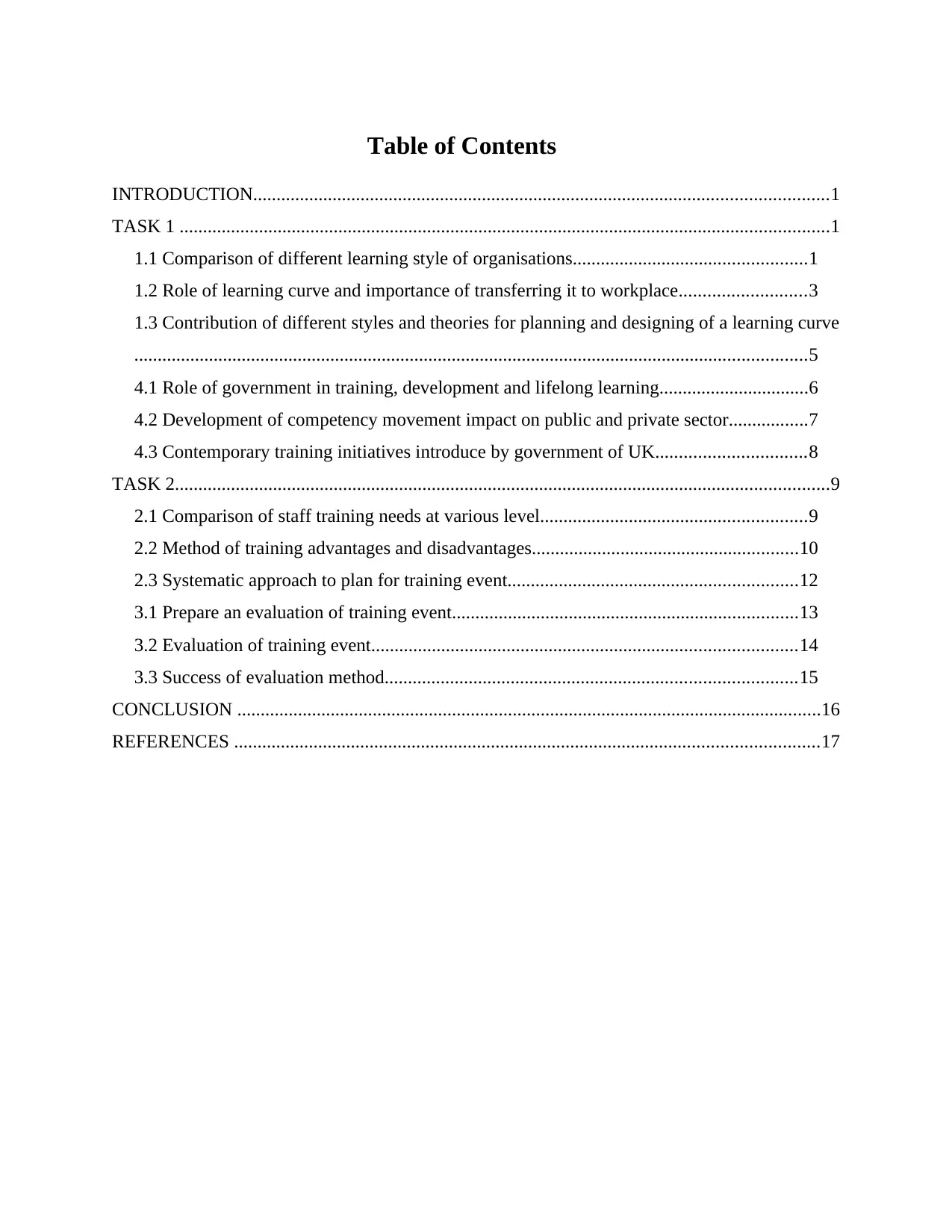
Table of Contents
INTRODUCTION...........................................................................................................................1
TASK 1 ...........................................................................................................................................1
1.1 Comparison of different learning style of organisations..................................................1
1.2 Role of learning curve and importance of transferring it to workplace...........................3
1.3 Contribution of different styles and theories for planning and designing of a learning curve
................................................................................................................................................5
4.1 Role of government in training, development and lifelong learning................................6
4.2 Development of competency movement impact on public and private sector.................7
4.3 Contemporary training initiatives introduce by government of UK................................8
TASK 2............................................................................................................................................9
2.1 Comparison of staff training needs at various level.........................................................9
2.2 Method of training advantages and disadvantages.........................................................10
2.3 Systematic approach to plan for training event..............................................................12
3.1 Prepare an evaluation of training event..........................................................................13
3.2 Evaluation of training event...........................................................................................14
3.3 Success of evaluation method........................................................................................15
CONCLUSION .............................................................................................................................16
REFERENCES .............................................................................................................................17
INTRODUCTION...........................................................................................................................1
TASK 1 ...........................................................................................................................................1
1.1 Comparison of different learning style of organisations..................................................1
1.2 Role of learning curve and importance of transferring it to workplace...........................3
1.3 Contribution of different styles and theories for planning and designing of a learning curve
................................................................................................................................................5
4.1 Role of government in training, development and lifelong learning................................6
4.2 Development of competency movement impact on public and private sector.................7
4.3 Contemporary training initiatives introduce by government of UK................................8
TASK 2............................................................................................................................................9
2.1 Comparison of staff training needs at various level.........................................................9
2.2 Method of training advantages and disadvantages.........................................................10
2.3 Systematic approach to plan for training event..............................................................12
3.1 Prepare an evaluation of training event..........................................................................13
3.2 Evaluation of training event...........................................................................................14
3.3 Success of evaluation method........................................................................................15
CONCLUSION .............................................................................................................................16
REFERENCES .............................................................................................................................17
⊘ This is a preview!⊘
Do you want full access?
Subscribe today to unlock all pages.

Trusted by 1+ million students worldwide
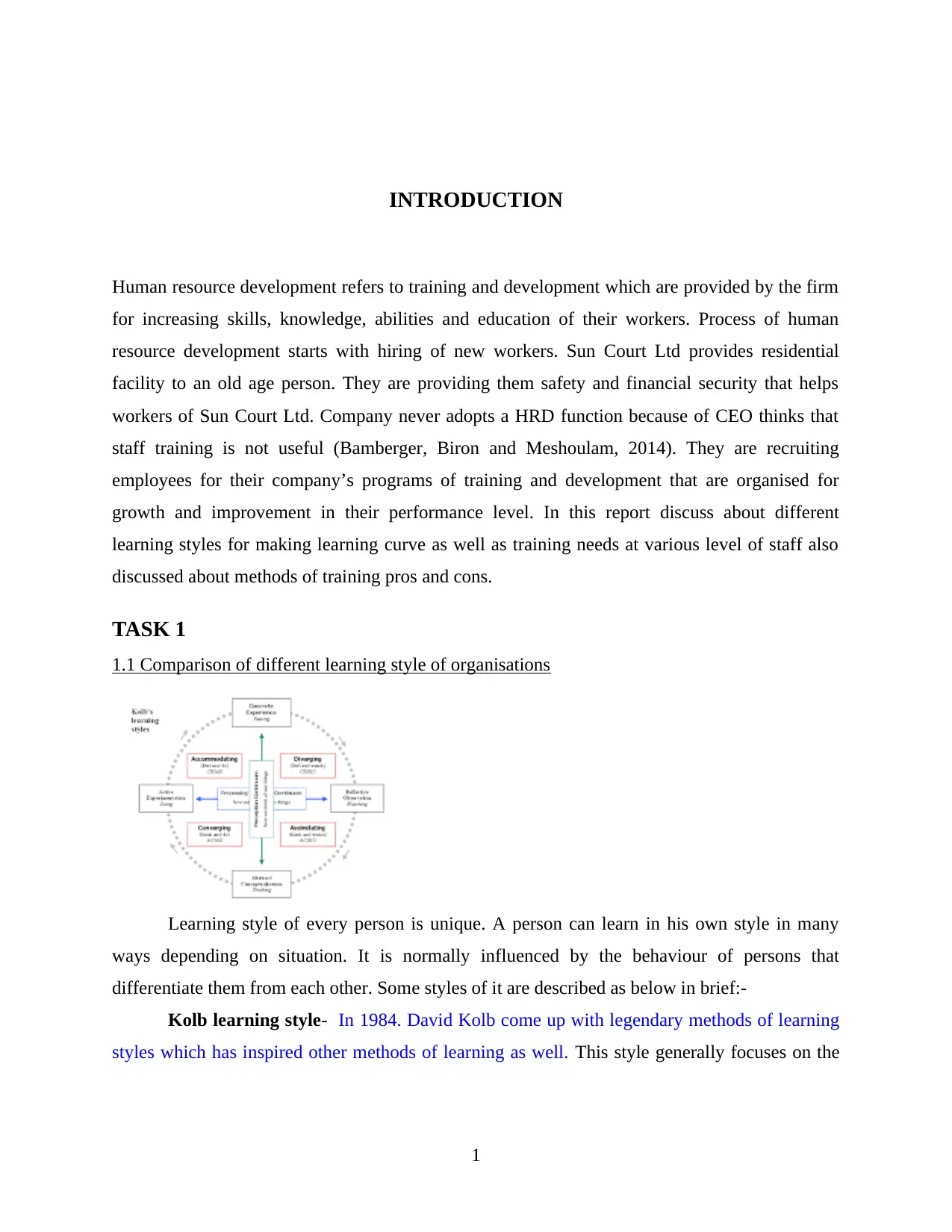
INTRODUCTION
Human resource development refers to training and development which are provided by the firm
for increasing skills, knowledge, abilities and education of their workers. Process of human
resource development starts with hiring of new workers. Sun Court Ltd provides residential
facility to an old age person. They are providing them safety and financial security that helps
workers of Sun Court Ltd. Company never adopts a HRD function because of CEO thinks that
staff training is not useful (Bamberger, Biron and Meshoulam, 2014). They are recruiting
employees for their company’s programs of training and development that are organised for
growth and improvement in their performance level. In this report discuss about different
learning styles for making learning curve as well as training needs at various level of staff also
discussed about methods of training pros and cons.
TASK 1
1.1 Comparison of different learning style of organisations
Learning style of every person is unique. A person can learn in his own style in many
ways depending on situation. It is normally influenced by the behaviour of persons that
differentiate them from each other. Some styles of it are described as below in brief:-
Kolb learning style- In 1984. David Kolb come up with legendary methods of learning
styles which has inspired other methods of learning as well. This style generally focuses on the
1
Human resource development refers to training and development which are provided by the firm
for increasing skills, knowledge, abilities and education of their workers. Process of human
resource development starts with hiring of new workers. Sun Court Ltd provides residential
facility to an old age person. They are providing them safety and financial security that helps
workers of Sun Court Ltd. Company never adopts a HRD function because of CEO thinks that
staff training is not useful (Bamberger, Biron and Meshoulam, 2014). They are recruiting
employees for their company’s programs of training and development that are organised for
growth and improvement in their performance level. In this report discuss about different
learning styles for making learning curve as well as training needs at various level of staff also
discussed about methods of training pros and cons.
TASK 1
1.1 Comparison of different learning style of organisations
Learning style of every person is unique. A person can learn in his own style in many
ways depending on situation. It is normally influenced by the behaviour of persons that
differentiate them from each other. Some styles of it are described as below in brief:-
Kolb learning style- In 1984. David Kolb come up with legendary methods of learning
styles which has inspired other methods of learning as well. This style generally focuses on the
1
Paraphrase This Document
Need a fresh take? Get an instant paraphrase of this document with our AI Paraphraser
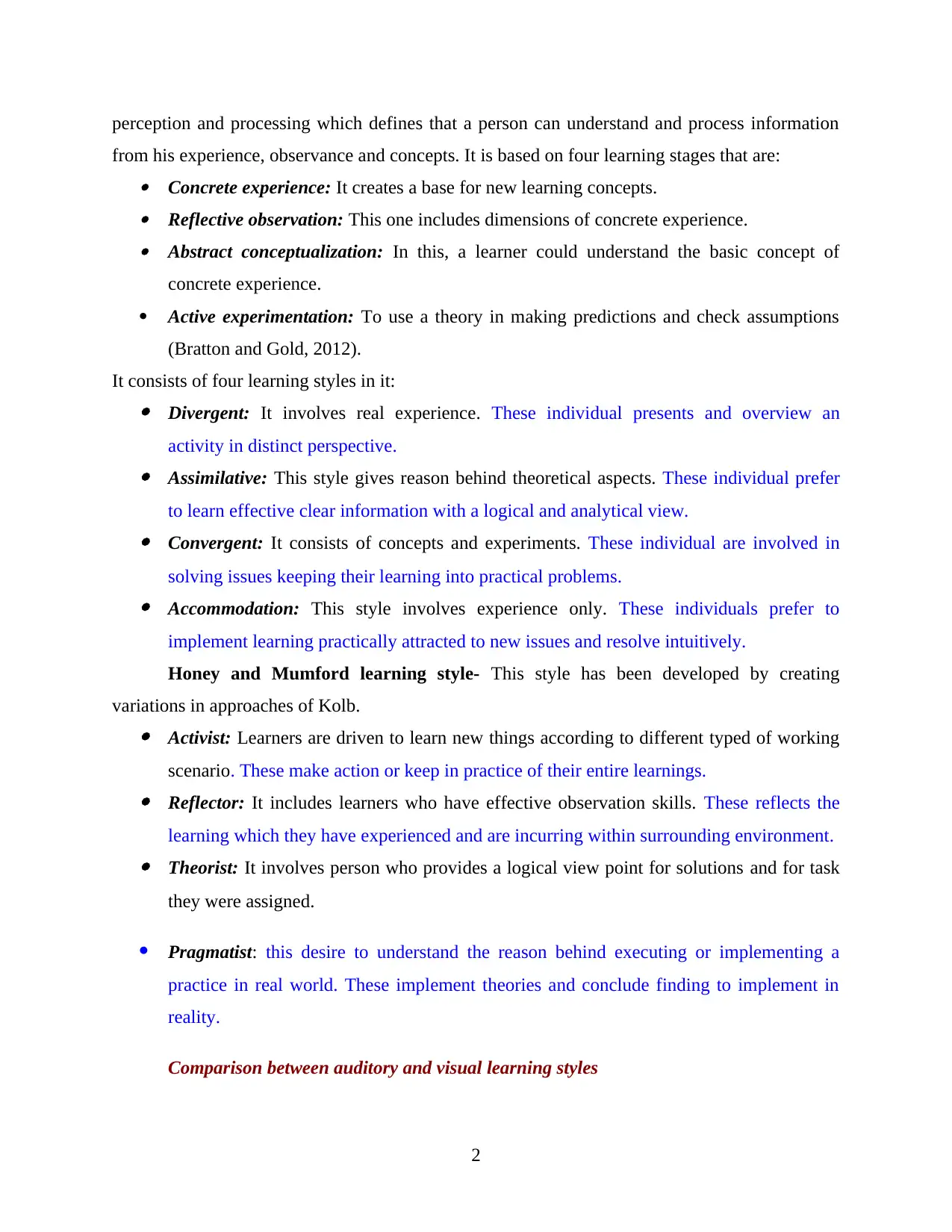
perception and processing which defines that a person can understand and process information
from his experience, observance and concepts. It is based on four learning stages that are: Concrete experience: It creates a base for new learning concepts. Reflective observation: This one includes dimensions of concrete experience. Abstract conceptualization: In this, a learner could understand the basic concept of
concrete experience.
Active experimentation: To use a theory in making predictions and check assumptions
(Bratton and Gold, 2012).
It consists of four learning styles in it: Divergent: It involves real experience. These individual presents and overview an
activity in distinct perspective. Assimilative: This style gives reason behind theoretical aspects. These individual prefer
to learn effective clear information with a logical and analytical view. Convergent: It consists of concepts and experiments. These individual are involved in
solving issues keeping their learning into practical problems. Accommodation: This style involves experience only. These individuals prefer to
implement learning practically attracted to new issues and resolve intuitively.
Honey and Mumford learning style- This style has been developed by creating
variations in approaches of Kolb. Activist: Learners are driven to learn new things according to different typed of working
scenario. These make action or keep in practice of their entire learnings. Reflector: It includes learners who have effective observation skills. These reflects the
learning which they have experienced and are incurring within surrounding environment. Theorist: It involves person who provides a logical view point for solutions and for task
they were assigned.
Pragmatist: this desire to understand the reason behind executing or implementing a
practice in real world. These implement theories and conclude finding to implement in
reality.
Comparison between auditory and visual learning styles
2
from his experience, observance and concepts. It is based on four learning stages that are: Concrete experience: It creates a base for new learning concepts. Reflective observation: This one includes dimensions of concrete experience. Abstract conceptualization: In this, a learner could understand the basic concept of
concrete experience.
Active experimentation: To use a theory in making predictions and check assumptions
(Bratton and Gold, 2012).
It consists of four learning styles in it: Divergent: It involves real experience. These individual presents and overview an
activity in distinct perspective. Assimilative: This style gives reason behind theoretical aspects. These individual prefer
to learn effective clear information with a logical and analytical view. Convergent: It consists of concepts and experiments. These individual are involved in
solving issues keeping their learning into practical problems. Accommodation: This style involves experience only. These individuals prefer to
implement learning practically attracted to new issues and resolve intuitively.
Honey and Mumford learning style- This style has been developed by creating
variations in approaches of Kolb. Activist: Learners are driven to learn new things according to different typed of working
scenario. These make action or keep in practice of their entire learnings. Reflector: It includes learners who have effective observation skills. These reflects the
learning which they have experienced and are incurring within surrounding environment. Theorist: It involves person who provides a logical view point for solutions and for task
they were assigned.
Pragmatist: this desire to understand the reason behind executing or implementing a
practice in real world. These implement theories and conclude finding to implement in
reality.
Comparison between auditory and visual learning styles
2
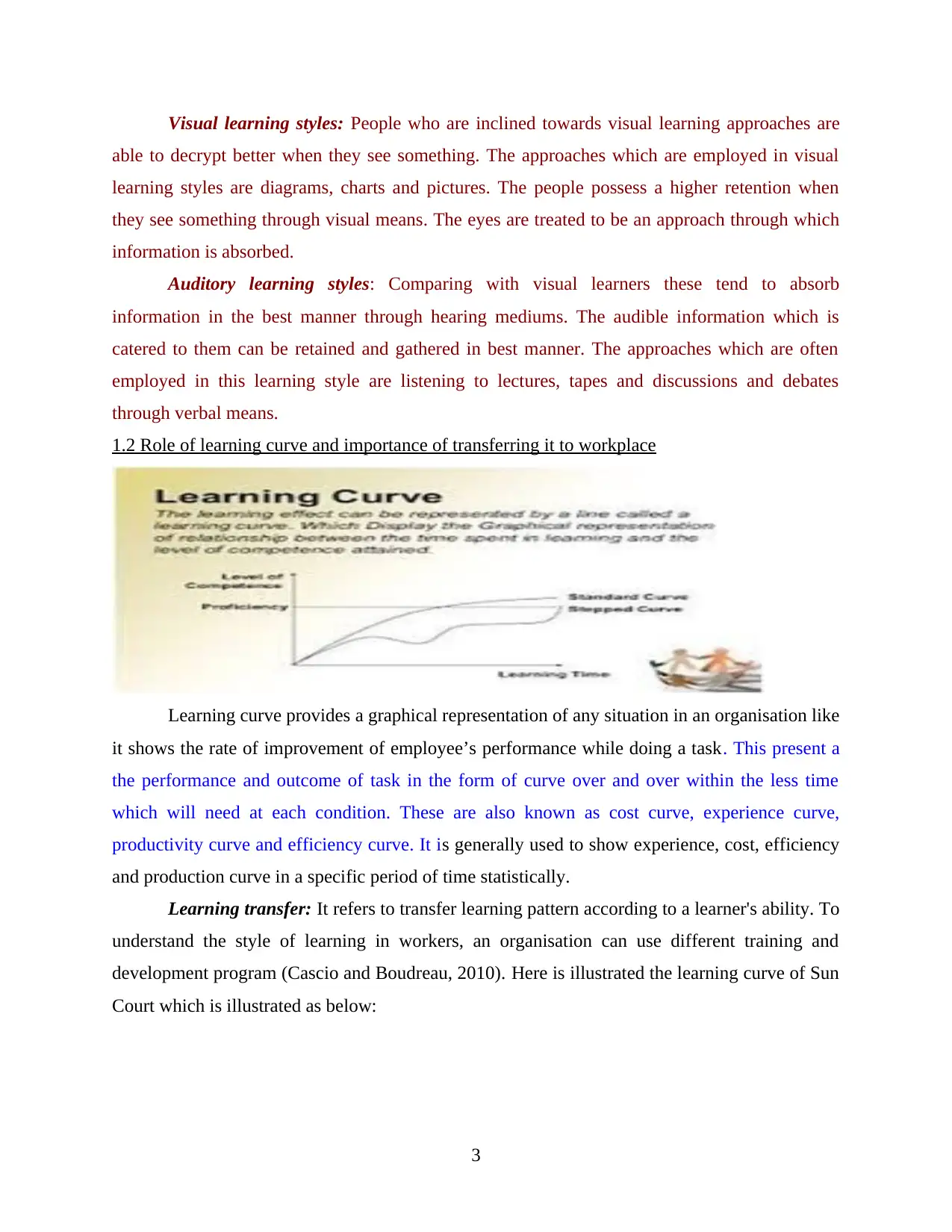
Visual learning styles: People who are inclined towards visual learning approaches are
able to decrypt better when they see something. The approaches which are employed in visual
learning styles are diagrams, charts and pictures. The people possess a higher retention when
they see something through visual means. The eyes are treated to be an approach through which
information is absorbed.
Auditory learning styles: Comparing with visual learners these tend to absorb
information in the best manner through hearing mediums. The audible information which is
catered to them can be retained and gathered in best manner. The approaches which are often
employed in this learning style are listening to lectures, tapes and discussions and debates
through verbal means.
1.2 Role of learning curve and importance of transferring it to workplace
Learning curve provides a graphical representation of any situation in an organisation like
it shows the rate of improvement of employee’s performance while doing a task. This present a
the performance and outcome of task in the form of curve over and over within the less time
which will need at each condition. These are also known as cost curve, experience curve,
productivity curve and efficiency curve. It is generally used to show experience, cost, efficiency
and production curve in a specific period of time statistically.
Learning transfer: It refers to transfer learning pattern according to a learner's ability. To
understand the style of learning in workers, an organisation can use different training and
development program (Cascio and Boudreau, 2010). Here is illustrated the learning curve of Sun
Court which is illustrated as below:
3
able to decrypt better when they see something. The approaches which are employed in visual
learning styles are diagrams, charts and pictures. The people possess a higher retention when
they see something through visual means. The eyes are treated to be an approach through which
information is absorbed.
Auditory learning styles: Comparing with visual learners these tend to absorb
information in the best manner through hearing mediums. The audible information which is
catered to them can be retained and gathered in best manner. The approaches which are often
employed in this learning style are listening to lectures, tapes and discussions and debates
through verbal means.
1.2 Role of learning curve and importance of transferring it to workplace
Learning curve provides a graphical representation of any situation in an organisation like
it shows the rate of improvement of employee’s performance while doing a task. This present a
the performance and outcome of task in the form of curve over and over within the less time
which will need at each condition. These are also known as cost curve, experience curve,
productivity curve and efficiency curve. It is generally used to show experience, cost, efficiency
and production curve in a specific period of time statistically.
Learning transfer: It refers to transfer learning pattern according to a learner's ability. To
understand the style of learning in workers, an organisation can use different training and
development program (Cascio and Boudreau, 2010). Here is illustrated the learning curve of Sun
Court which is illustrated as below:
3
⊘ This is a preview!⊘
Do you want full access?
Subscribe today to unlock all pages.

Trusted by 1+ million students worldwide
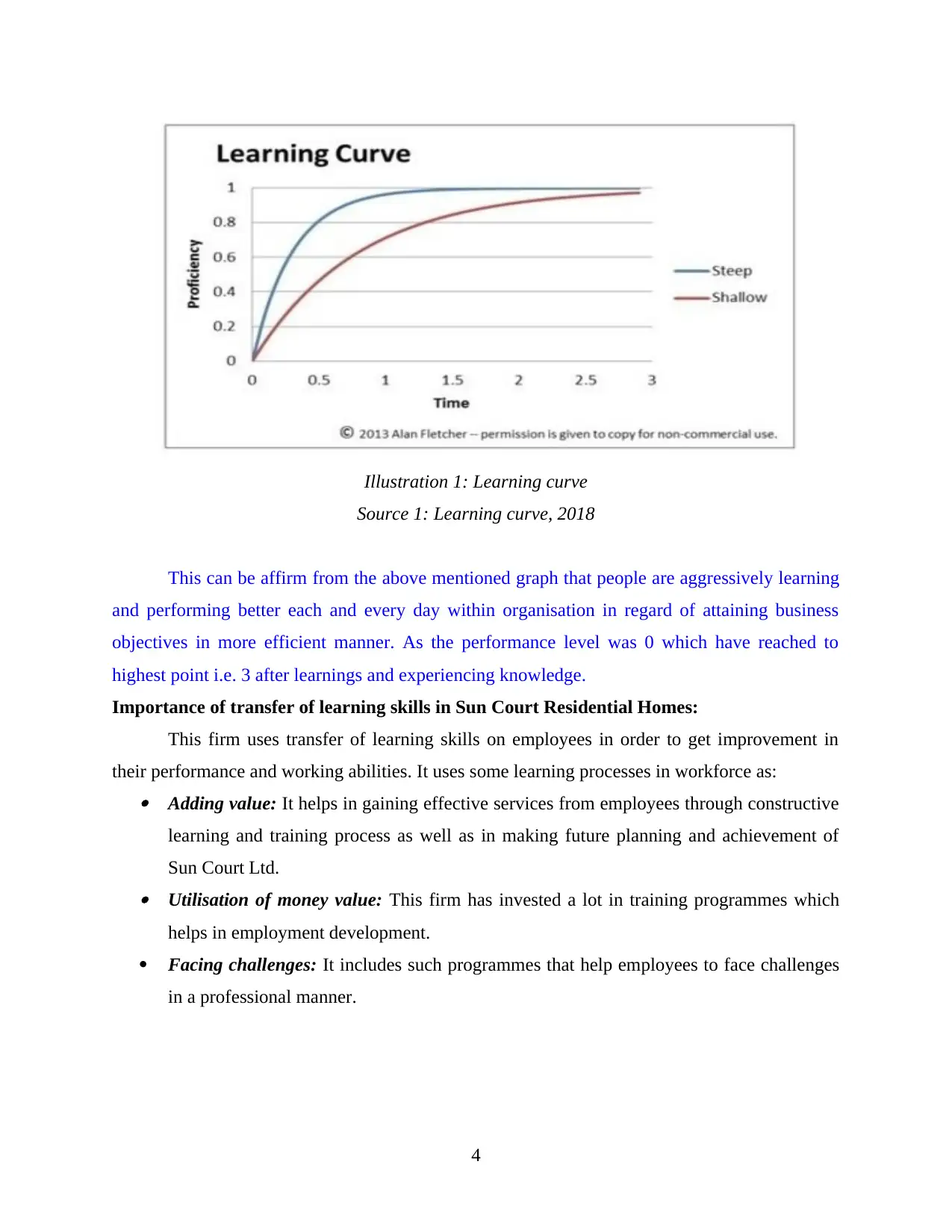
This can be affirm from the above mentioned graph that people are aggressively learning
and performing better each and every day within organisation in regard of attaining business
objectives in more efficient manner. As the performance level was 0 which have reached to
highest point i.e. 3 after learnings and experiencing knowledge.
Importance of transfer of learning skills in Sun Court Residential Homes:
This firm uses transfer of learning skills on employees in order to get improvement in
their performance and working abilities. It uses some learning processes in workforce as: Adding value: It helps in gaining effective services from employees through constructive
learning and training process as well as in making future planning and achievement of
Sun Court Ltd. Utilisation of money value: This firm has invested a lot in training programmes which
helps in employment development.
Facing challenges: It includes such programmes that help employees to face challenges
in a professional manner.
4
Illustration 1: Learning curve
Source 1: Learning curve, 2018
and performing better each and every day within organisation in regard of attaining business
objectives in more efficient manner. As the performance level was 0 which have reached to
highest point i.e. 3 after learnings and experiencing knowledge.
Importance of transfer of learning skills in Sun Court Residential Homes:
This firm uses transfer of learning skills on employees in order to get improvement in
their performance and working abilities. It uses some learning processes in workforce as: Adding value: It helps in gaining effective services from employees through constructive
learning and training process as well as in making future planning and achievement of
Sun Court Ltd. Utilisation of money value: This firm has invested a lot in training programmes which
helps in employment development.
Facing challenges: It includes such programmes that help employees to face challenges
in a professional manner.
4
Illustration 1: Learning curve
Source 1: Learning curve, 2018
Paraphrase This Document
Need a fresh take? Get an instant paraphrase of this document with our AI Paraphraser
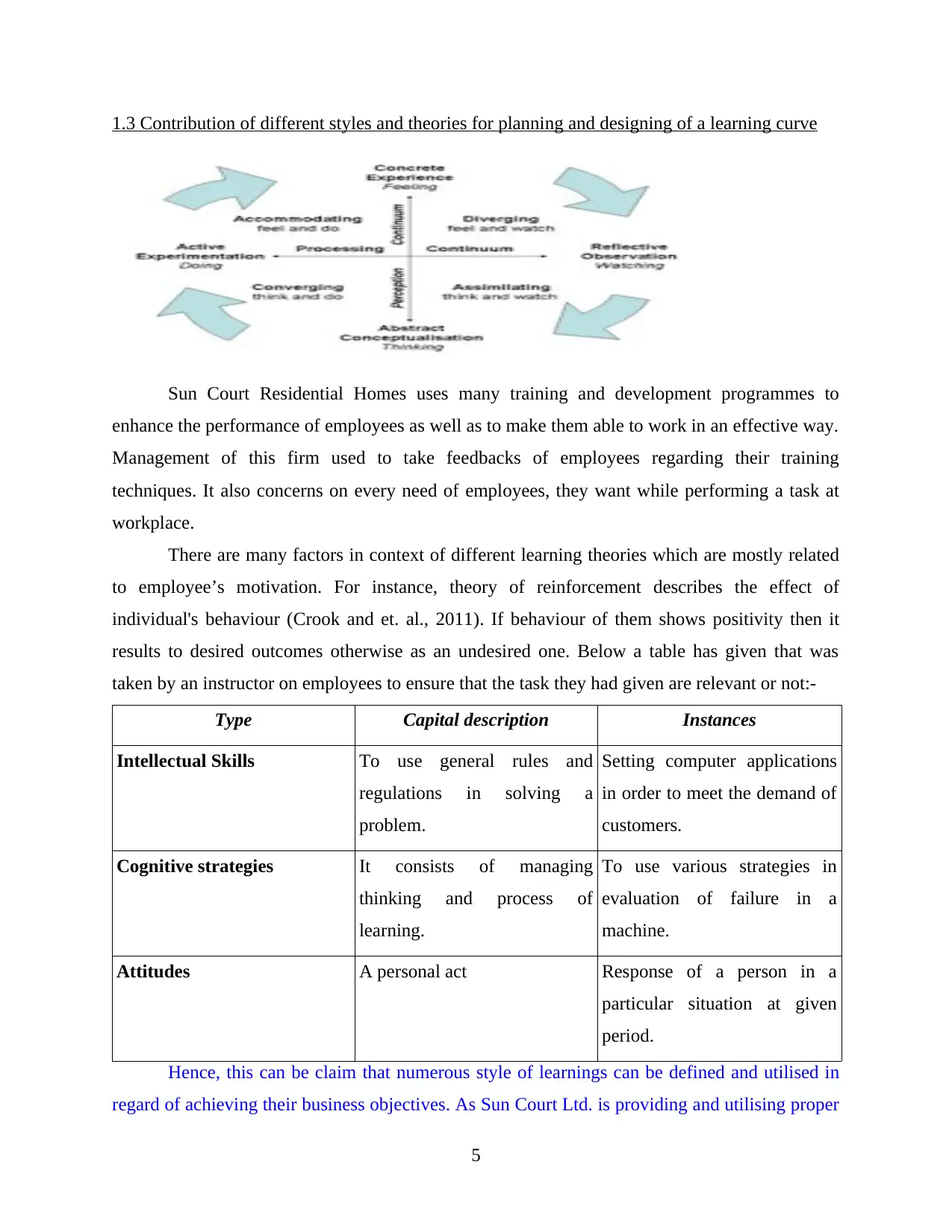
1.3 Contribution of different styles and theories for planning and designing of a learning curve
Sun Court Residential Homes uses many training and development programmes to
enhance the performance of employees as well as to make them able to work in an effective way.
Management of this firm used to take feedbacks of employees regarding their training
techniques. It also concerns on every need of employees, they want while performing a task at
workplace.
There are many factors in context of different learning theories which are mostly related
to employee’s motivation. For instance, theory of reinforcement describes the effect of
individual's behaviour (Crook and et. al., 2011). If behaviour of them shows positivity then it
results to desired outcomes otherwise as an undesired one. Below a table has given that was
taken by an instructor on employees to ensure that the task they had given are relevant or not:-
Type Capital description Instances
Intellectual Skills To use general rules and
regulations in solving a
problem.
Setting computer applications
in order to meet the demand of
customers.
Cognitive strategies It consists of managing
thinking and process of
learning.
To use various strategies in
evaluation of failure in a
machine.
Attitudes A personal act Response of a person in a
particular situation at given
period.
Hence, this can be claim that numerous style of learnings can be defined and utilised in
regard of achieving their business objectives. As Sun Court Ltd. is providing and utilising proper
5
Sun Court Residential Homes uses many training and development programmes to
enhance the performance of employees as well as to make them able to work in an effective way.
Management of this firm used to take feedbacks of employees regarding their training
techniques. It also concerns on every need of employees, they want while performing a task at
workplace.
There are many factors in context of different learning theories which are mostly related
to employee’s motivation. For instance, theory of reinforcement describes the effect of
individual's behaviour (Crook and et. al., 2011). If behaviour of them shows positivity then it
results to desired outcomes otherwise as an undesired one. Below a table has given that was
taken by an instructor on employees to ensure that the task they had given are relevant or not:-
Type Capital description Instances
Intellectual Skills To use general rules and
regulations in solving a
problem.
Setting computer applications
in order to meet the demand of
customers.
Cognitive strategies It consists of managing
thinking and process of
learning.
To use various strategies in
evaluation of failure in a
machine.
Attitudes A personal act Response of a person in a
particular situation at given
period.
Hence, this can be claim that numerous style of learnings can be defined and utilised in
regard of achieving their business objectives. As Sun Court Ltd. is providing and utilising proper
5
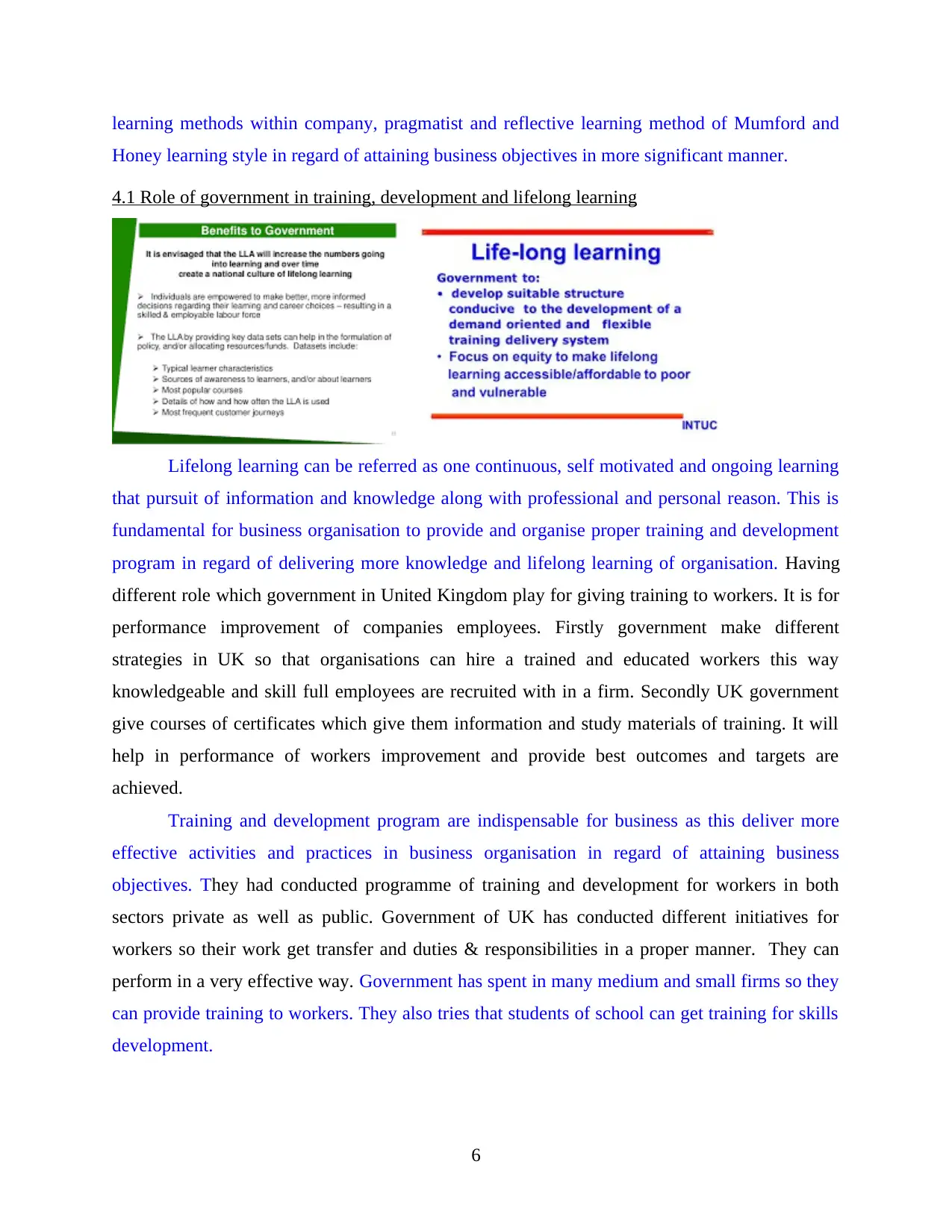
learning methods within company, pragmatist and reflective learning method of Mumford and
Honey learning style in regard of attaining business objectives in more significant manner.
4.1 Role of government in training, development and lifelong learning
Lifelong learning can be referred as one continuous, self motivated and ongoing learning
that pursuit of information and knowledge along with professional and personal reason. This is
fundamental for business organisation to provide and organise proper training and development
program in regard of delivering more knowledge and lifelong learning of organisation. Having
different role which government in United Kingdom play for giving training to workers. It is for
performance improvement of companies employees. Firstly government make different
strategies in UK so that organisations can hire a trained and educated workers this way
knowledgeable and skill full employees are recruited with in a firm. Secondly UK government
give courses of certificates which give them information and study materials of training. It will
help in performance of workers improvement and provide best outcomes and targets are
achieved.
Training and development program are indispensable for business as this deliver more
effective activities and practices in business organisation in regard of attaining business
objectives. They had conducted programme of training and development for workers in both
sectors private as well as public. Government of UK has conducted different initiatives for
workers so their work get transfer and duties & responsibilities in a proper manner. They can
perform in a very effective way. Government has spent in many medium and small firms so they
can provide training to workers. They also tries that students of school can get training for skills
development.
6
Honey learning style in regard of attaining business objectives in more significant manner.
4.1 Role of government in training, development and lifelong learning
Lifelong learning can be referred as one continuous, self motivated and ongoing learning
that pursuit of information and knowledge along with professional and personal reason. This is
fundamental for business organisation to provide and organise proper training and development
program in regard of delivering more knowledge and lifelong learning of organisation. Having
different role which government in United Kingdom play for giving training to workers. It is for
performance improvement of companies employees. Firstly government make different
strategies in UK so that organisations can hire a trained and educated workers this way
knowledgeable and skill full employees are recruited with in a firm. Secondly UK government
give courses of certificates which give them information and study materials of training. It will
help in performance of workers improvement and provide best outcomes and targets are
achieved.
Training and development program are indispensable for business as this deliver more
effective activities and practices in business organisation in regard of attaining business
objectives. They had conducted programme of training and development for workers in both
sectors private as well as public. Government of UK has conducted different initiatives for
workers so their work get transfer and duties & responsibilities in a proper manner. They can
perform in a very effective way. Government has spent in many medium and small firms so they
can provide training to workers. They also tries that students of school can get training for skills
development.
6
⊘ This is a preview!⊘
Do you want full access?
Subscribe today to unlock all pages.

Trusted by 1+ million students worldwide
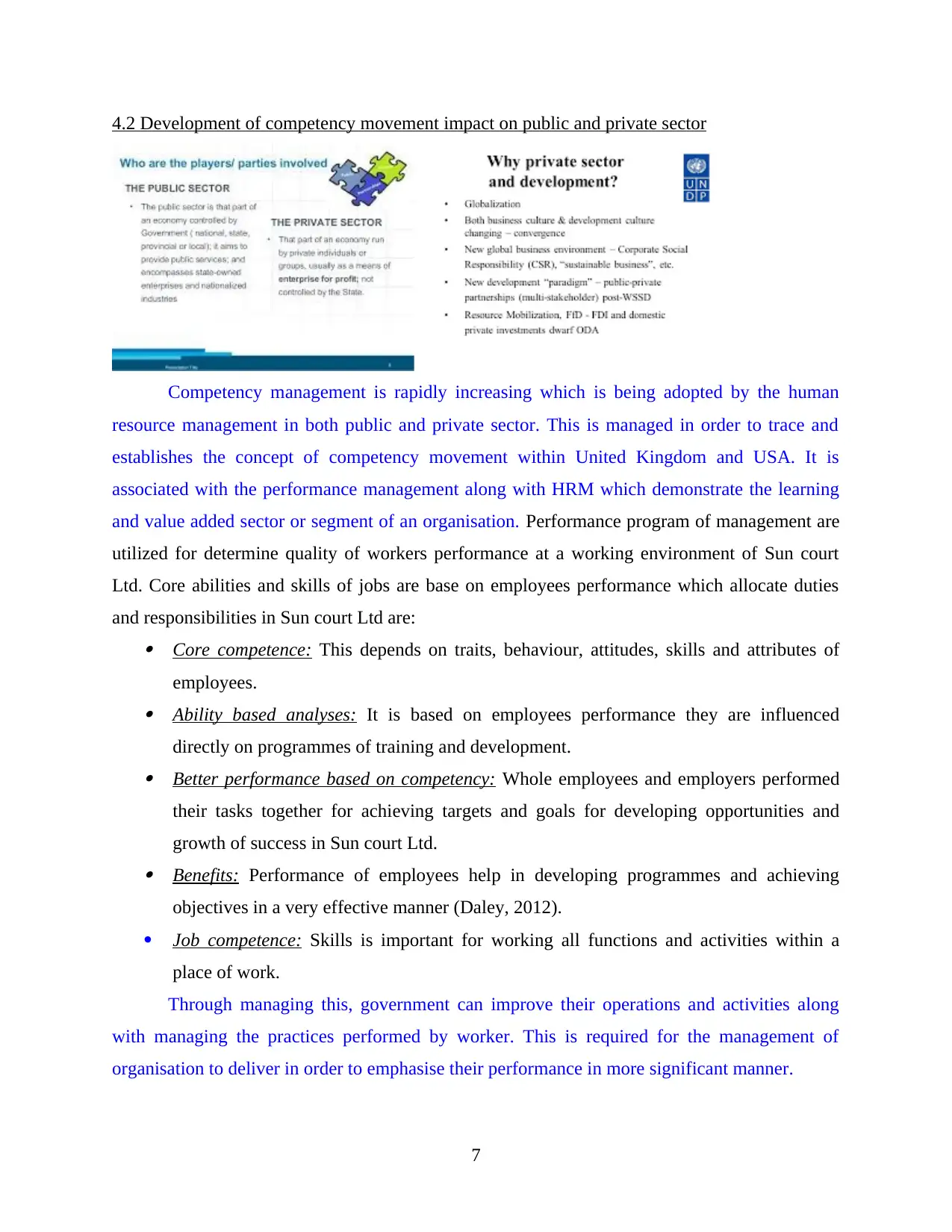
4.2 Development of competency movement impact on public and private sector
Competency management is rapidly increasing which is being adopted by the human
resource management in both public and private sector. This is managed in order to trace and
establishes the concept of competency movement within United Kingdom and USA. It is
associated with the performance management along with HRM which demonstrate the learning
and value added sector or segment of an organisation. Performance program of management are
utilized for determine quality of workers performance at a working environment of Sun court
Ltd. Core abilities and skills of jobs are base on employees performance which allocate duties
and responsibilities in Sun court Ltd are: Core competence: This depends on traits, behaviour, attitudes, skills and attributes of
employees. Ability based analyses: It is based on employees performance they are influenced
directly on programmes of training and development. Better performance based on competency: Whole employees and employers performed
their tasks together for achieving targets and goals for developing opportunities and
growth of success in Sun court Ltd. Benefits: Performance of employees help in developing programmes and achieving
objectives in a very effective manner (Daley, 2012).
Job competence: Skills is important for working all functions and activities within a
place of work.
Through managing this, government can improve their operations and activities along
with managing the practices performed by worker. This is required for the management of
organisation to deliver in order to emphasise their performance in more significant manner.
7
Competency management is rapidly increasing which is being adopted by the human
resource management in both public and private sector. This is managed in order to trace and
establishes the concept of competency movement within United Kingdom and USA. It is
associated with the performance management along with HRM which demonstrate the learning
and value added sector or segment of an organisation. Performance program of management are
utilized for determine quality of workers performance at a working environment of Sun court
Ltd. Core abilities and skills of jobs are base on employees performance which allocate duties
and responsibilities in Sun court Ltd are: Core competence: This depends on traits, behaviour, attitudes, skills and attributes of
employees. Ability based analyses: It is based on employees performance they are influenced
directly on programmes of training and development. Better performance based on competency: Whole employees and employers performed
their tasks together for achieving targets and goals for developing opportunities and
growth of success in Sun court Ltd. Benefits: Performance of employees help in developing programmes and achieving
objectives in a very effective manner (Daley, 2012).
Job competence: Skills is important for working all functions and activities within a
place of work.
Through managing this, government can improve their operations and activities along
with managing the practices performed by worker. This is required for the management of
organisation to deliver in order to emphasise their performance in more significant manner.
7
Paraphrase This Document
Need a fresh take? Get an instant paraphrase of this document with our AI Paraphraser

4.3 Contemporary training initiatives introduce by government of UK
UK government has different initiatives for developing personal work in Sun court Ltd.
Associations are organised for handling and observing these matters are:
Department of sector and commerce
Division of grant and work
Division of health
Services are rendered by UK government with agencies which are owned by private are given
below:
Supporting business operations effectively which help in needy and demanding
individual.
Monitoring better practices of work or targets with people standard.
Investments of funds for education and learning with some university certificate in a very
effective manner
Providing skills and abilities for business operations with enterprise are linked to skill
council
Hence, this can be explained and managed numerous practices that can emphasise over
the development of organisation in efficient manner. The above mentioned division is
undertaking and controlling activities of training, knowledge and development of worker which
can achieve their business objectives in significant manner. They have initiated the program i.e.
“Building engagement, building futures” which is undertaking numerous activities to empower
worker in efficient manner. Along with this, numerous activities are provided i.e. National
vocational qualification, People standards, Apprenticeship programs, train to gain etc. which are
made to provide positive influence to organisation in more efficient manner.
8
UK government has different initiatives for developing personal work in Sun court Ltd.
Associations are organised for handling and observing these matters are:
Department of sector and commerce
Division of grant and work
Division of health
Services are rendered by UK government with agencies which are owned by private are given
below:
Supporting business operations effectively which help in needy and demanding
individual.
Monitoring better practices of work or targets with people standard.
Investments of funds for education and learning with some university certificate in a very
effective manner
Providing skills and abilities for business operations with enterprise are linked to skill
council
Hence, this can be explained and managed numerous practices that can emphasise over
the development of organisation in efficient manner. The above mentioned division is
undertaking and controlling activities of training, knowledge and development of worker which
can achieve their business objectives in significant manner. They have initiated the program i.e.
“Building engagement, building futures” which is undertaking numerous activities to empower
worker in efficient manner. Along with this, numerous activities are provided i.e. National
vocational qualification, People standards, Apprenticeship programs, train to gain etc. which are
made to provide positive influence to organisation in more efficient manner.
8
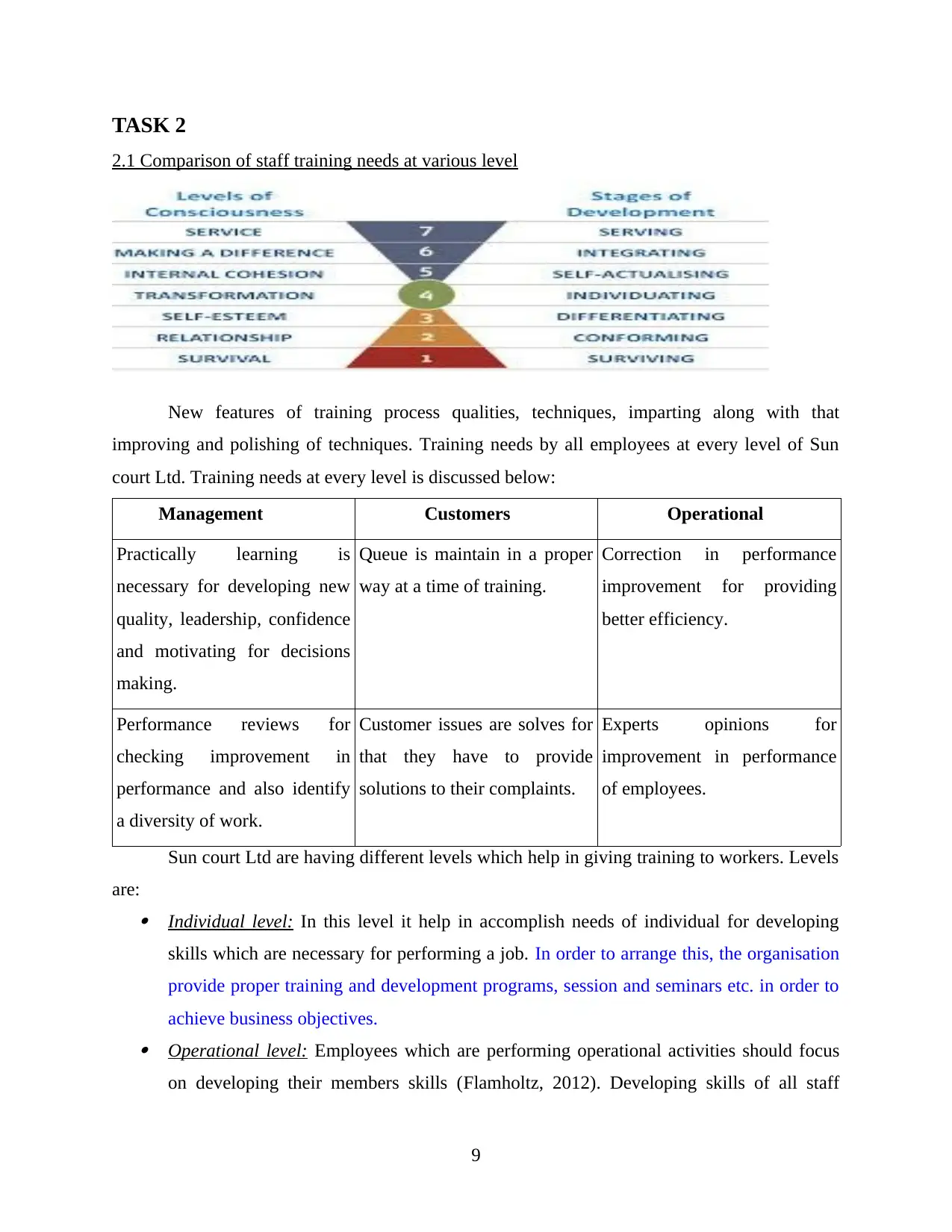
TASK 2
2.1 Comparison of staff training needs at various level
New features of training process qualities, techniques, imparting along with that
improving and polishing of techniques. Training needs by all employees at every level of Sun
court Ltd. Training needs at every level is discussed below:
Management Customers Operational
Practically learning is
necessary for developing new
quality, leadership, confidence
and motivating for decisions
making.
Queue is maintain in a proper
way at a time of training.
Correction in performance
improvement for providing
better efficiency.
Performance reviews for
checking improvement in
performance and also identify
a diversity of work.
Customer issues are solves for
that they have to provide
solutions to their complaints.
Experts opinions for
improvement in performance
of employees.
Sun court Ltd are having different levels which help in giving training to workers. Levels
are: Individual level: In this level it help in accomplish needs of individual for developing
skills which are necessary for performing a job. In order to arrange this, the organisation
provide proper training and development programs, session and seminars etc. in order to
achieve business objectives. Operational level: Employees which are performing operational activities should focus
on developing their members skills (Flamholtz, 2012). Developing skills of all staff
9
2.1 Comparison of staff training needs at various level
New features of training process qualities, techniques, imparting along with that
improving and polishing of techniques. Training needs by all employees at every level of Sun
court Ltd. Training needs at every level is discussed below:
Management Customers Operational
Practically learning is
necessary for developing new
quality, leadership, confidence
and motivating for decisions
making.
Queue is maintain in a proper
way at a time of training.
Correction in performance
improvement for providing
better efficiency.
Performance reviews for
checking improvement in
performance and also identify
a diversity of work.
Customer issues are solves for
that they have to provide
solutions to their complaints.
Experts opinions for
improvement in performance
of employees.
Sun court Ltd are having different levels which help in giving training to workers. Levels
are: Individual level: In this level it help in accomplish needs of individual for developing
skills which are necessary for performing a job. In order to arrange this, the organisation
provide proper training and development programs, session and seminars etc. in order to
achieve business objectives. Operational level: Employees which are performing operational activities should focus
on developing their members skills (Flamholtz, 2012). Developing skills of all staff
9
⊘ This is a preview!⊘
Do you want full access?
Subscribe today to unlock all pages.

Trusted by 1+ million students worldwide
1 out of 20
Related Documents
Your All-in-One AI-Powered Toolkit for Academic Success.
+13062052269
info@desklib.com
Available 24*7 on WhatsApp / Email
![[object Object]](/_next/static/media/star-bottom.7253800d.svg)
Unlock your academic potential
Copyright © 2020–2025 A2Z Services. All Rights Reserved. Developed and managed by ZUCOL.





